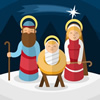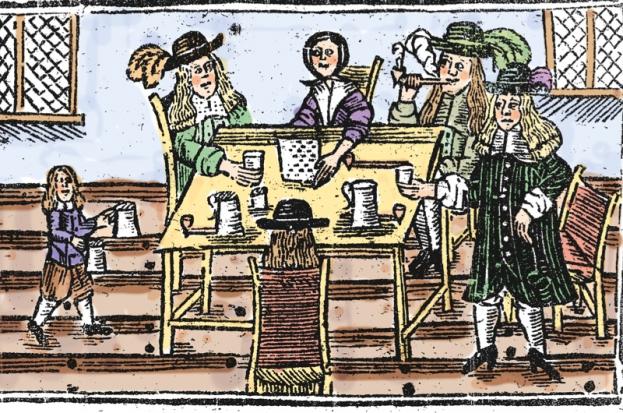A (brief) History of Christmas – Part 1
A history of Christmas might sound like a fairly simple undertaking. From nativity, to church, to family, to commerce – a story of high beginnings, a cosy, warm middle and the chill of cold hard cash and commercialism at the end.
However its not quote that simple – the type of Christmas we celebrate today has a very winding tale indeed. In a series of 2 articles we track the History of the Christmas we know (& love ?) of today. You may not know its traditions as well as you think.
Part 1 takes us from 337 AD to 1728 and Part 2 from the 1770s to 1891.
 A Brief History – Part 1
A Brief History – Part 1
-
 The earliest evidence we have for a celebration of Christ’s birth is when Julius I, Bishop of Rome (337-352), decreed that Christ’s nativity was to be observed on December 25.
The earliest evidence we have for a celebration of Christ’s birth is when Julius I, Bishop of Rome (337-352), decreed that Christ’s nativity was to be observed on December 25.Why then? According to biblical scholars’ calculations, based on the gospels and other church writings, April 17, May 29 and September 15 are all more likely dates for the birth of Jesus.
If Mary gave birth in December, why were the sheep still in the fields in the winter months when they should have been taken in to the villages for warmth?
The choice of December 25 seems instead to have been tied to the winter solstice, the shortest day of the year.
-
 The Venerable Bede claimed in about 730 AD that ancient Britons referred to December and January as Yule, probably derived from a Norse word, “jul”, which originally meant festivities.
The Venerable Bede claimed in about 730 AD that ancient Britons referred to December and January as Yule, probably derived from a Norse word, “jul”, which originally meant festivities.The word Christmas, or rather Cristesmresse – Christ’s mass – replaced Yule in the British Isles some time after the 9th century.
The use of Christmas gradually became standard, and Yule returned only in the 19th century, with the rekindling of the love for ancient traditions.
-
 By the 11th century in France, a star was hung over church altars for an Epiphany play that was incorporated into the mass, and the story of the Magi, of Herod and the Massacre of the Innocents was acted out.
By the 11th century in France, a star was hung over church altars for an Epiphany play that was incorporated into the mass, and the story of the Magi, of Herod and the Massacre of the Innocents was acted out. In the 12th century, English churches also staged these plays.
Another form of theatre originated with Francis of Assisi, who in 1223 produced a replica of a stable, with a manger, an ox and an ass (although his animals were real and not yet models).
-
 One 16th-century historian claimed that in previous centuries every parish had a great pole serving as a maypole in the summer, decorated with holly and ivy in the winter. This was not a Christmas tree as we know it but it might be considered a precursor.
One 16th-century historian claimed that in previous centuries every parish had a great pole serving as a maypole in the summer, decorated with holly and ivy in the winter. This was not a Christmas tree as we know it but it might be considered a precursor.An association between trees and Christmas was emerging, especially in Germany, and by 1531 there was a new fashion, with Strasbourg markets selling trees for people to erect indoors, although these were apparently not yet decorated.
The first decorated indoor tree we know of appeared in 1605, again in Strasbourg. Adorned with paper roses, apples, wafers, gilded sweets and sugar ornaments, it was what, a few years later, would be given a new name – a Weihnachtsbaum, or Christmas tree.
-
 The English Civil War was unkind to Christmas. The reformers saw Christmas, of which there was no mention in the Bible, as a mark of the antichrist.
The English Civil War was unkind to Christmas. The reformers saw Christmas, of which there was no mention in the Bible, as a mark of the antichrist.In 1643 Oliver Cromwell’s parliament sat on December 25 to make sure everyone understood this was to be a working day like any other.
By 1645 it was decreed that :
“Festival days, vulgarly called Holy days, having no Warrant in the Word of God, are not to be continued.“
The English ban did not survive long after Cromwell’ s death.
-
 The earliest Christmas presents were socially upward gifts of obligation – to a sovereign from the nobles; to a landowner from the tenants.
The earliest Christmas presents were socially upward gifts of obligation – to a sovereign from the nobles; to a landowner from the tenants.However by the end of the 18th century a downward tradition was emerging – from employers to their workers (in the form of bonuses or tips) and most importantly, for the first time, from parents to children.
One of the first advertisements in Britain to promote a Christmas gift was printed in 1728: a necklace for a baby.
By 1743 an anthology of stories, jokes and other light fare was advertised with the subtitle “A Christmas-box for gay Gallants and good Companions”. The most common Christmas gift for children became books, with toys not far behind.






